It is still possible to sail in Irish waters in your own cruiser-racer without involving enormous expense. You just have to be prepared to do it in a boat of economical size which is far from being the newest available. Admittedly you have to be skilled in your own maintenance in continuing to get full use from equipment which is well-proven through years of experience in its use. Then too, you have to be carefully selective in finding a mooring or berthing location which doesn’t cost the earth, and you have to be modest in your expectations of what you can achieve afloat, particularly if there are racing ambitions in the equation.
Of course, it is increasingly possible to sail in charge of a boat without having to own one. Talented potential Sailing Masters are soon identified by owners keen to win. And the development of boat rental is only in its infancy in much of Ireland on the sea coasts. Yet it’s obviously the only way to go for people with a reluctance to become too totally involved, their “rent it” approach reflecting today’s developing Tasting Menu Lifestyle.
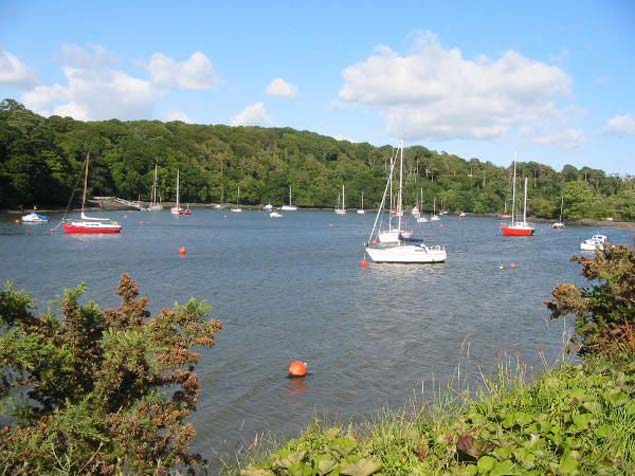 Drake’s Pool in Cork Harbour, a haven for those for whom boat-owning is a vocation
Drake’s Pool in Cork Harbour, a haven for those for whom boat-owning is a vocation
But for some, boat-owning is a vocation in itself. In fact, for some simply owning a boat is what it’s all about – the sailing is secondary. But whatever your way of looking at it, and at whatever level it’s made, the fact is that sailing is first and foremost a vehicle sport, and that involves costs which don’t arise in more straightforward athletic and other arena sports, which have the added advantage of the possibility of spectators prepared to pay to watch the action.
That generates a cash flow which – even with the most advanced new communications technology to follow a boat race – is difficult for sailing to provide. Yet despite that, sailing requires a significant capital outlay at some level, with a continuing rate of expenditure for it to happen at all.
The problem is rapidly exacerbated when international competition is expected as part of the programme, For sure, we can get reasonably inexpensive sailing if we stay at home on our relatively sparsely-populated little island with its wide choice of natural harbours, and freely available sailing water.
But if we seek the intensive sailing competition which is more readily available in the sailing areas used by highly-concentrated and affluent populations, the costs start to rise astronomically. And Ireland’s relative isolation immediately imposes that built-in travel expense at the most basic level before we’ve even got to the scene of the action.
The challenge which this poses was highlighted a month ago when Irish Sailing invited expressions of interests from individuals and teams – crews if you prefer – who might commit towards a campaign which could result in selection to sail for Ireland in the proposed two-person offshore racer – one woman, one man – which will feature in the 2024 Paris Olympics.
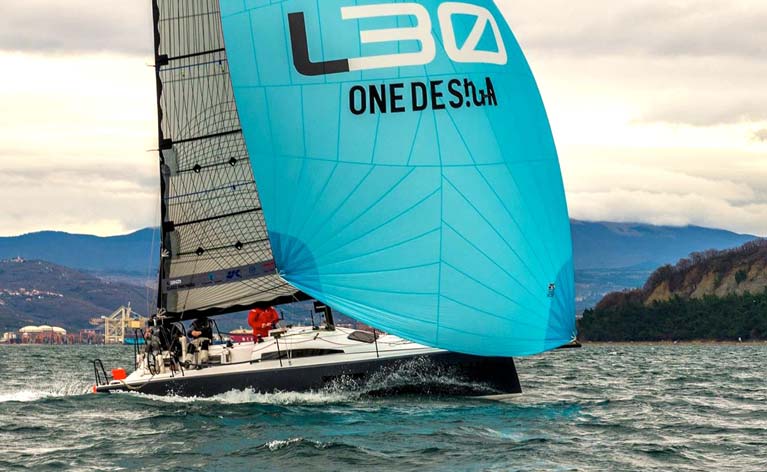 Designed by Olympic and Volvo Racer Rodion Luka of Ukraine, the L30 will be used for the World Offshore Championship 2020 in Malta in October
Designed by Olympic and Volvo Racer Rodion Luka of Ukraine, the L30 will be used for the World Offshore Championship 2020 in Malta in October
The sailing events in 2024 will be staged at Marseilles. It’s a significant distance from the main Olympic focus in Paris, but as it will involve racing on Mediterranean waters, 2020’s Offshore World Championship in concert with the Middle Sea Race in Malta at the end of October is seen as part of the buildup.
Irish Sailing made it clear that at the moment no funds are available for this new area for Olympic sailing, and with the level of longterm commitment involved, coupled with the annual Christmas/New Year hiatus in any official administration, we would not expect an announcement of definite plans at this early juncture.
But what it does mean is that there will be a clearcut regatta structure with boats of the Ukrainian Rodion Luka-designed L30 class available in Malta in the Autumn, and inevitably the overall framework of the new Olympic class circuit will draw on experience gained by the French offshore racing experience over fifty years and more in organising events like the Figaro, the MiniTransat and other majors where Open 40s and IMOCA 60s feature prominently.
Thus yet again we’ve to face the reality that any young Irish sailor keen to make the grade on the international offshore scene as an individual achiever - rather than as a professional crewmember - has to do it through the highly-structured French setup, as is currently seen with Tom Dolan and Joan Mulloy with the Figaro circuit, where Conor Fogerty is also involved.
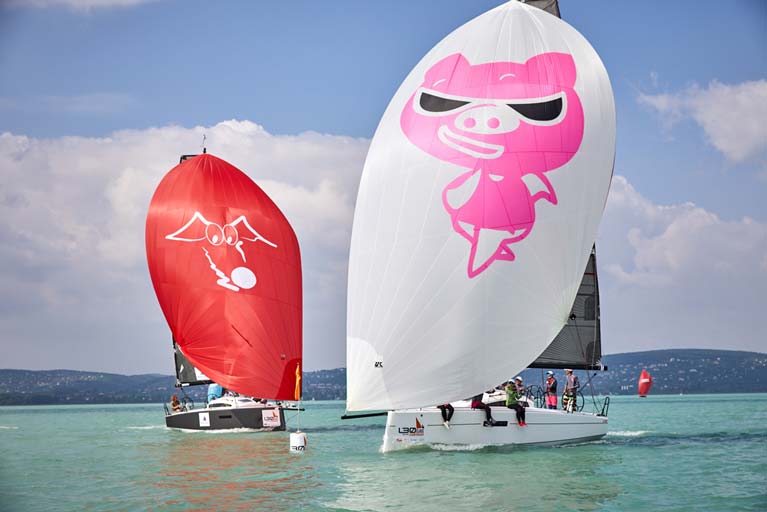 The L30 is multi-purpose, and like the JPK range, it aims to provide a genuine cruiser within the racer parameters.
The L30 is multi-purpose, and like the JPK range, it aims to provide a genuine cruiser within the racer parameters.
As for the additional cohort which will emerge from the Expression of Interest invitation, we would hope to see the names of Dillon, Rumball, O’Leary, Kenefick and others appear. But until the list is made official, we can think of many perfectly valid reasons why some top sailors of proven offshore ability would react with: “Thanks, but no thanks”.
For inevitably, the new Olympic offshore racing project will see increasingly complex official administration and detailed multi-media coverage, such that the tone of the event is beginning to seem a whole world away from the almost buccaneering atmosphere which prevails around established offshore classics, where larger-than-life characters put together colourful campaigns which reflect individual flair, enormous energy, and maybe very deep pockets too.
It’s a scenario that has seen imaginative solutions which achieved success in times past. But equally sailing history reveals occasions when possible solutions to the challenge of long-distance campaigns were less than satisfactory. To revert to the Olympics for one instance, back in 1964, the first Japanese Olympics post World War II were staged in Tokyo.
In its favour, it has to be said the event was staged in late October, when the weather is much less oppressively hot and humid than will be the case in July this year. But for the small Irish sailing team in 1964 of a Dragon skippered by Eddie Kelliher and crewed by Rob d’Alton and Harry Maguire, and a Finn sailed by Johnny Hooper, the sheer distance and the paucity of resources proved a major drawback.
 Ireland’s 1964 Olympic Dragon crew in Japan were (left to right) Rob d’Alton, Harry Maguire, and skipper Eddie Kelliher.
Ireland’s 1964 Olympic Dragon crew in Japan were (left to right) Rob d’Alton, Harry Maguire, and skipper Eddie Kelliher.
There was no question of shipping Kelliher’s successful Dragon Ysolde to Japan, so – like three other far-travelling teams - they took up the offer of a boat chartered from the small Dragon fleet in Japan, and brought their own sails. But once there, it emerged that the chartered boat had a mast so flawed that they had to scour the store-yard in search of a replacement, and as soon as the boat was put afloat it was discovered that the rudder was so faulty that they’d to lift out again and work round the clock in order to be able to sail.
Not surprisingly the boat’s performance overall was woeful, yet despite that they were usually in the frame in the early stages, getting good starts, and managing in one race to be first at the windward mark. But at the end, as Team Manager Leo Flanagan of Skerries reported, while they did finish as best overall of all the chartered boats, any future involvement in the Olympics must necessarily involve bringing the team’s own boat, as the three medallists had boats which were in a league of their own.
Fifty-six years on, and the Dragon class is Olympic sailing history, while thriving as never before as a private International One Design boat in its own closed circuit. As for the Olympic ideal, that is now for the host country to supply all boats on site for total uniformity, in the expectation that crews will already be well experienced in the boat types either through fleets in their own country, or in clusters based on groups of nations.
Either way, it is going to involve Irish crews in travel and all other expenses of overseas campaigning within a framework which – with 2024 already accelerating towards us – is going to be set by the French way of doing things, but it’s going to be the French way with an even further overlay of official administration set in a very European context.
For the fact is that the French sailing scene is so large and complex that within it you can find colourful instances of creative and imaginative individuality in non-Olympic sailing, but nevertheless in the 2016 Olympic Sailing Games they returned with three medals – a Gold and two Bronzes.
It’s a respectable enough total, but not outstanding, so success for France in the additional Offshore Class to the Paris Olympics will be a matter of intense ambition. Yet it could well be that the process of getting selected for such a coveted role in a very clearly designated route to nomination will be so fierce as to be psychologically damaging.
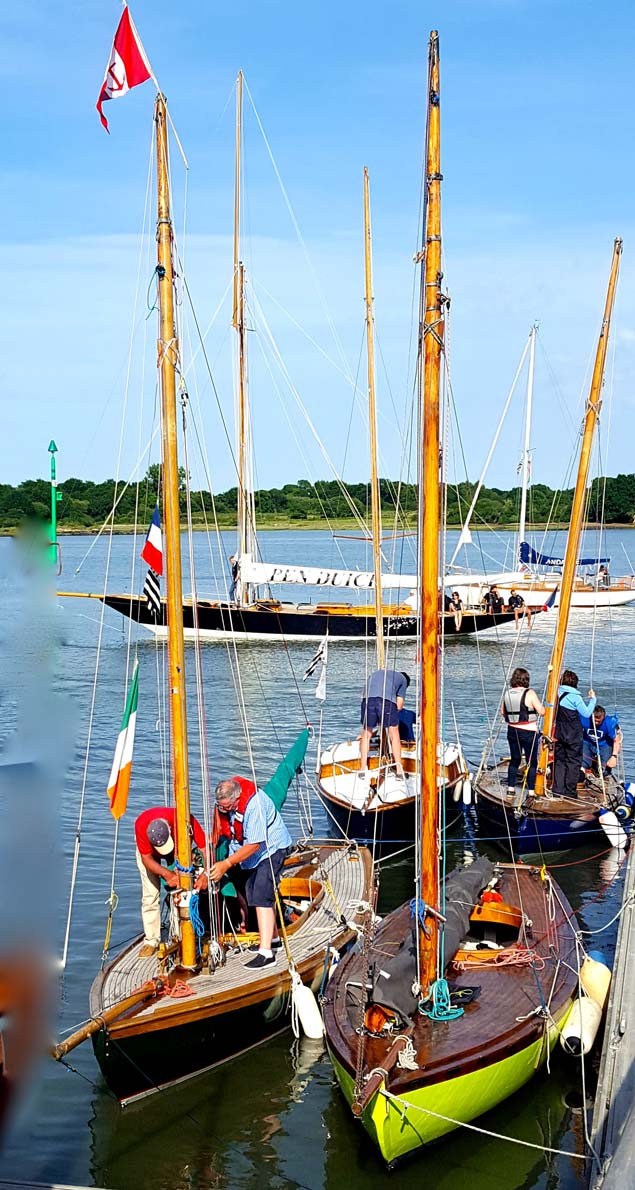 The inspiration. Eric Tabarly’s beloved classic Fife cutter Pen Duick (built in Cork Harbour in 1898) at the Festival of Sail in The Morbihan in Brittany in May 2018 with boats of the Howth 17 Class (built in Carrickfergus in 1898)
The inspiration. Eric Tabarly’s beloved classic Fife cutter Pen Duick (built in Cork Harbour in 1898) at the Festival of Sail in The Morbihan in Brittany in May 2018 with boats of the Howth 17 Class (built in Carrickfergus in 1898)
For the great joy in assessing French sailing achievement is in relishing the unfettered inspirational individuality of the people involved, something which goes right back to the achievements of Eric Tabarly and beyond. These days, the spirit is well evoked by many top sailors, but one whose has genius in finding visionary logistical solutions on a high level is Gery Trentesaux.
We’re reminded of this with the news that his multiple-race-winning First 40 of ten years ago is joining the fleet in Dublin Bay. For although most folk will assure you that it is wellnigh impossible to get the mighty firm of Beneteau to change the specification of any of their middle range boats during construction, as the boat coming to Dublin Bay proves, the bould Gery was able to get them to give it a special hull lay-up and a completely new keel design, so this is no ordinary First 40.
After that, there was a meeting of minds when Gery linked up with boat-builder Jean-Pierre Kelbert, and he took the then-new JPK 10.80 to Cowes Week, where the hottest boat in the Solent was Adam Gosling’s Corby 36 Yes!. Once upon a time she was Peter Wilson’s Mustang Sally based in Howth, but in Cowes had been given a complete makeover to become the new Yes!, and Cowes Week champion two years running.
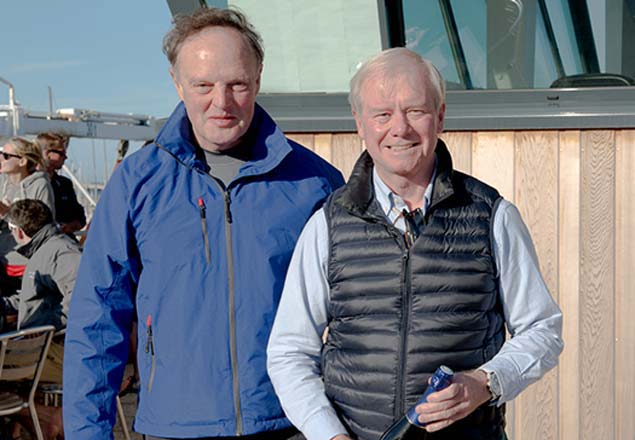 Ireland’s Michael Boyd (when Commodore of the RORC) with Gery Trentesaux
Ireland’s Michael Boyd (when Commodore of the RORC) with Gery Trentesaux
Things seemed to be following the same route the following year when Yes! and the new JPK arrived together at the weather mark in the first race, and then set off on a spinnaker reach, with the French boat’s spinnaker being trimmed by an amiable-looking bald guy smoking a pipe. By the time they reached the next mark, the JPK was at least a quarter of a mile ahead, without much apparent effort.
It was the fact that the bald guy felt relaxed enough to be calmly smoking pipe that did it. A new Yes!, a dark blue JPK 10.80 designed only for day racing, was soon on the way, and she launched her career by winning overall in the Round the Island Race the following year with Nin O’Leary calling the shots.
But Gery Trentesaux had by this time moved on, with his JPK 10.80 winning the Fastnet Race overall, and he soon had an idea of purest logistical genius. The JPK 10.80 really is a genuine cruiser-racer, and one of the boats was cruising the Pacific. Her owners were persuaded to shape their course for Sydney, where Gery and his crew were waiting with a completely new wardrobe of top racing sails, all nicely in time for the Rolex Sydney-Hobart Race 2015.
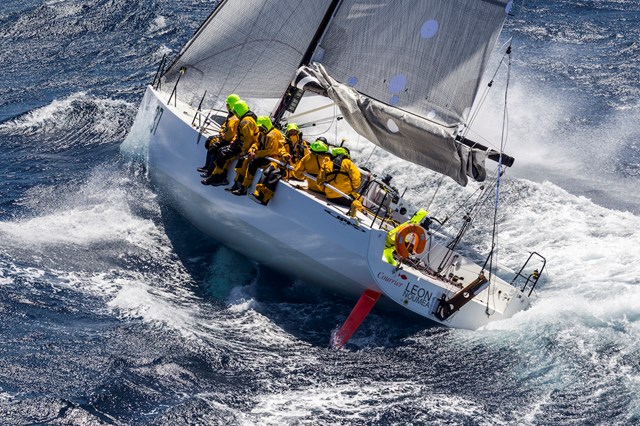 Same name, different boat – Gery Trentesaux’s borrowed JPK 10.80 Courier de Leon (with a Pacific Islands port of registry in Noumea) on her way to second overall in the 2015 Rolex Sydney-Hobart. Photo Rolex/Borlenghi
Same name, different boat – Gery Trentesaux’s borrowed JPK 10.80 Courier de Leon (with a Pacific Islands port of registry in Noumea) on her way to second overall in the 2015 Rolex Sydney-Hobart. Photo Rolex/Borlenghi
It was a very elegant solution to the challenges of long-distance campaigning, and in this their first Hobart Race, they were rewarded by taking second overall, a success which added to the mythology of the JPK story, which now includes Rolex Middle Sea Race wins and class dominance in the 2019 Rolex Fastnet Race, while last month’s Paris Boat Show saw Jean-Pierre Kelbert unveil the model of his latest baby, the JPK 10.30.
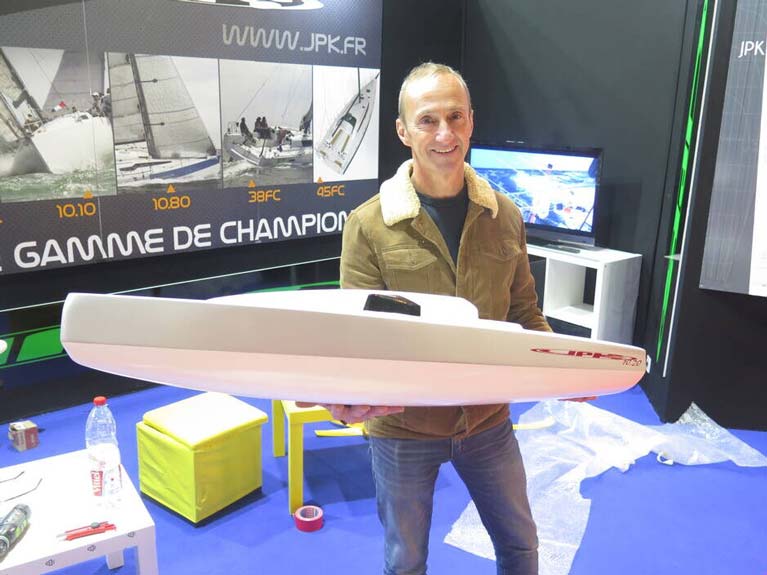 Jean-Pierre Kelbert with the model of his new JPK 10.30 at last month’s Paris Boat Show
Jean-Pierre Kelbert with the model of his new JPK 10.30 at last month’s Paris Boat Show
Other French international campaigners have come up with other solutions to the challenges of a privately-funded campaign in the Sydney-Hobart Race, and the recent 2019 race saw an interesting one with Frederic Puzin’s Ker 46 Daguet.
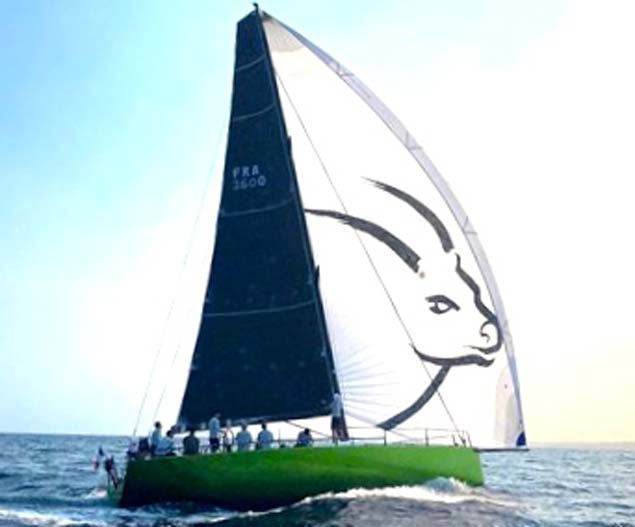 The Ker 46 Daguet (formerly Patrice) in training for the Sydney-Hobart race
The Ker 46 Daguet (formerly Patrice) in training for the Sydney-Hobart race
Puzin won the French Mediterranean Division 1 IRC championship in 2017 with his actively-campaigned Mylius 50 of the same name. But he reckoned that the hassle of getting the boat to Australia was out-weighed by the possibilities of having his own boat Down Under, so he bought the successful Sydney-based Ker 46 Patrice and after a massive re-vamp she re-appeared as the very green (as in leprechaun green) Daguet 3, racing to Hobart with a crew of several greats of French sailing such as Nicolas Troussel, Thomas Rouxel, and Sam Goodchild on board.
They certainly had their moments in the recent Hobart dash, giving Ichi Ban a hard time at one stage, and being indicated as overall leader at another. But in the end while they’d a first in ORCi-Div 2 and a fourth in IRC–Div 2, the relentless Sydney-Hobart grinding machine pushed them down to 29th overall in IRC.
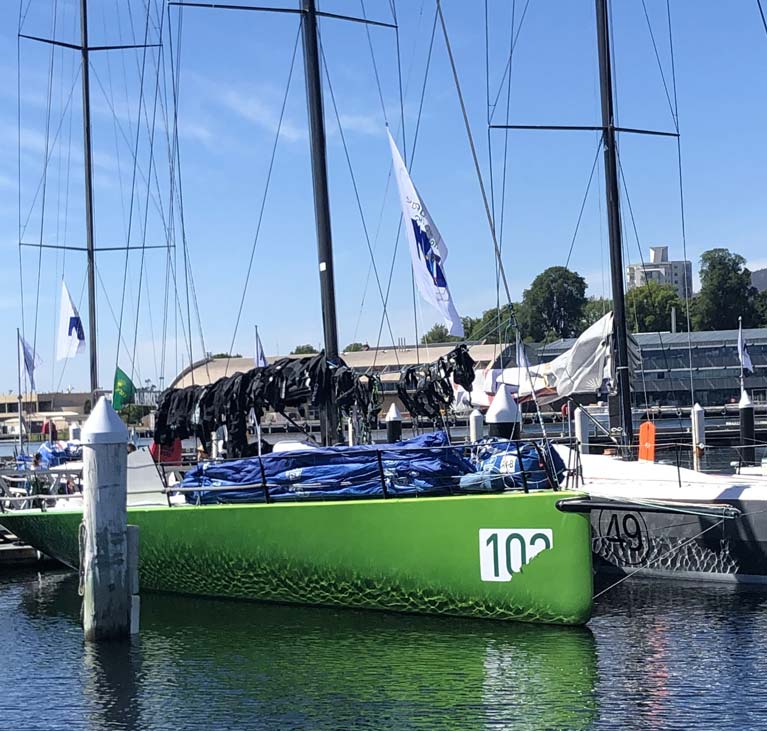 Daguet berthed in Hobart, where she acquired the nickname of Kermit. Photo: Ian Malcolm
Daguet berthed in Hobart, where she acquired the nickname of Kermit. Photo: Ian Malcolm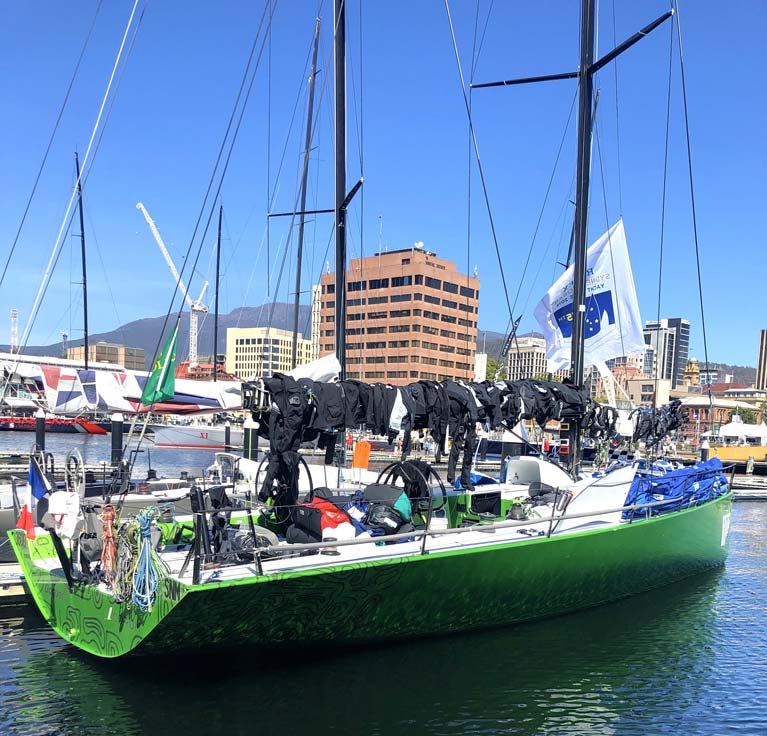 Daguet in Hobart. She may have slipped down the rankings after being first at one stage, but when the race is over the boat and gear still have to be cleaned, dried and stowed. Photo: Ian Malcolm
Daguet in Hobart. She may have slipped down the rankings after being first at one stage, but when the race is over the boat and gear still have to be cleaned, dried and stowed. Photo: Ian Malcolm
Nevertheless, French offshore racing now has a competitive proposition based in Australia and ready to go, and we may hear more of Daguet 3 in the months ahead. Meanwhile in Hobart, that totally green shade of green did not go unremarked, and the unfortunate Daguet 3 found herself nick-named Kermit, a bit of drollery which works very well at several levels, but none of them is politically correct in these very polite times…
































































